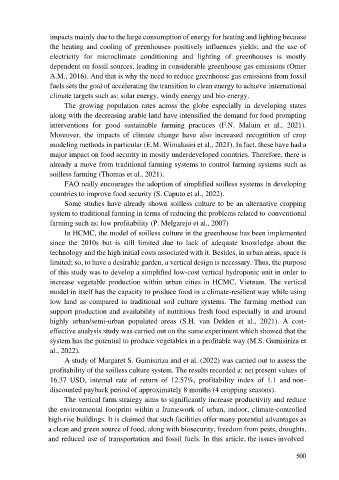Page 508 - Ebook HTKH 2024
P. 508
impacts mainly due to the large consumption of energy for heating and lighting because
the heating and cooling of greenhouses positively influences yields; and the use of
electricity for microclimate conditioning and lighting of greenhouses is mostly
dependent on fossil sources, leading in considerable greenhouse gas emissions (Omer
A.M., 2016). And that is why the need to reduce greenhouse gas emissions from fossil
fuels sets the goal of accelerating the transition to clean energy to achieve international
climate targets such as: solar energy, windy energy and bio-energy.
The growing population rates across the globe especially in developing states
along with the decreasing arable land have intensified the demand for food prompting
interventions for good sustainable farming practices (F.N. Maluin et al., 2021).
Moreover, the impacts of climate change have also increased recognition of crop
modeling methods in particular (E.M. Wimalasiri et al., 2021). In fact, these have had a
major impact on food security in mostly underdeveloped countries. Therefore, there is
already a move from traditional farming systems to control farming systems such as
soilless farming (Thomas et al., 2021).
FAO really encourages the adoption of simplified soilless systems in developing
countries to improve food security (S. Caputo et al., 2022).
Some studies have already shown soilless culture to be an alternative cropping
system to traditional farming in terms of reducing the problems related to conventional
farming such as; low profitability (P. Melgarejo et al., 2007)
In HCMC, the model of soilless culture in the greenhouse has been implemented
since the 2010s but is still limited due to lack of adequate knowledge about the
technology and the high initial costs associated with it. Besides, in urban areas, space is
limited; so, to have a desirable garden, a vertical design is necessary. Thus, the purpose
of this study was to develop a simplified low-cost vertical hydroponic unit in order to
increase vegetable production within urban cities in HCMC, Vietnam. The vertical
model in itself has the capacity to produce food in a climate-resilient way while using
low land as compared to traditional soil culture systems. The farming method can
support production and availability of nutritious fresh food especially in and around
highly urban/semi-urban populated areas (S.H. van Delden et al., 2021). A cost-
effective analysis study was carried out on the same experiment which showed that the
system has the potential to produce vegetables in a profitable way (M.S. Gumisiriza et
al., 2022).
A study of Margaret S. Gumisiriza and et al. (2022) was carried out to assess the
profitability of the soilless culture system. The results recorded a: net present values of
16.37 USD, internal rate of return of 12.57%, profitability index of 1.1 and non-
discounted payback period of approximately 8 months (4 cropping seasons).
The vertical farm strategy aims to significantly increase productivity and reduce
the environmental footprint within a framework of urban, indoor, climate-controlled
high-rise buildings. It is claimed that such facilities offer many potential advantages as
a clean and green source of food, along with biosecurity, freedom from pests, droughts,
and reduced use of transportation and fossil fuels. In this article, the issues involved
500

